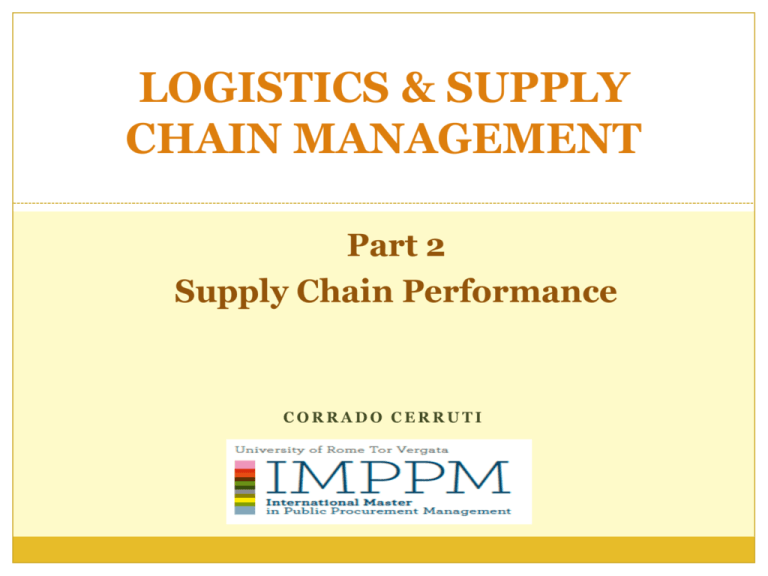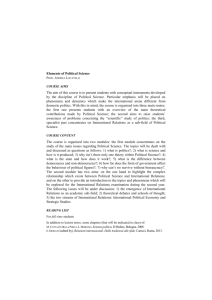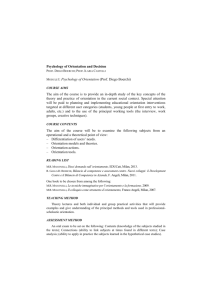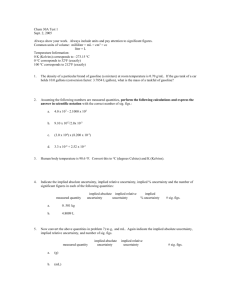Implied Demand Uncertainty
advertisement

LOGISTICS & SUPPLY CHAIN MANAGEMENT Part 2 Supply Chain Performance CORRADO CERRUTI Grant, L'analisi strategica per le decisioni aziendali, Il Mulino, 2011 Capitolo I. Il concetto di strategia Supply Chain Management Plan Source Make Deliver Buy A set of approaches used to efficiently integrate Suppliers Manufacturers Warehouses Distribution centers So that the product is produced and distributed In the right quantities To the right locations And at the right time System-wide costs are minimized and Service level requirements are satisfied 2 Grant, L'analisi strategica per le decisioni aziendali, Il Mulino, 2011 Capitolo I. Il concetto di strategia Why is SCM difficult? Plan Source Make Deliver Buy Uncertainty is inherent to every supply chain Travel times Breakdowns of machines and vehicles Weather, natural catastrophe, war Local politics, labor conditions, border issues The complexity of the problem to globally optimize a supply chain is significant Minimize internal costs Minimize uncertainty Deal with remaining uncertainty 3 Grant, L'analisi strategica per le decisioni aziendali, Il Mulino, 2011 Capitolo I. Il concetto di strategia The importance of SCM Shorter product life cycles of high-technology products Less opportunity to accumulate historical data on customer demand Wide choice of competing products makes it difficult to predict demand The growth of technologies such as the Internet enable greater collaboration between supply chain trading partners If you don’t do it, your competitor will Major buyers such as Wal-Mart demand a level of “supply chain maturity” of its suppliers Availability of SCM technologies on the market Firms have access to multiple products (e.g., SAP, Baan, Oracle, JD Edwards) with which to integrate internal processes 4 Grant, L'analisi strategica per le decisioni aziendali, Il Mulino, 2011 Capitolo I. Il concetto di strategia Fundamentals of Supply Chain Management 1. It views the supply chain as a single entity 2. It calls for strategic decision making 3. It provides a different perspective on inventories using them as a last, not first, resort 4. It requires a new approach to systems; integration not simply interface 5 Grant, L'analisi strategica per le decisioni aziendali, Il Mulino, 2011 Capitolo I. Il concetto di strategia Competitive and Supply Chain Strategies Competitive strategy: defines the set of customer needs a firm seeks to satisfy through its products and services Product development strategy: specifies the portfolio of new products that the company will try to develop Marketing and sales strategy: specifies how the market will be segmented and product positioned, priced, and promoted Supply chain strategy: determines the nature of material procurement, transportation of materials, manufacture of product or creation of service, distribution of product 6 Grant, L'analisi strategica per le decisioni aziendali, Il Mulino, 2011 Capitolo I. Il concetto di strategia Achieving Strategic Fit Strategic fit: Consistency between customer priorities of competitive strategy and supply chain capabilities specified by the supply chain strategy Competitive and supply chain strategies have the same goals A company may fail because of a lack of strategic fit or because its processes and resources do not provide the capabilities to execute the desired strategy To achieve strategic fit, a firm must ensure that its supply chain capabilities support its ability to satisfy the targeted customer segments. 7 Grant, L'analisi strategica per le decisioni aziendali, Il Mulino, 2011 Capitolo I. Il concetto di strategia How is Strategic Fit Achieved? Step 1: Understanding the customer and supply chain uncertainty Step 2: Understanding the supply chain and its response capabilities Step 3: Achieving strategic fit 8 Grant, L'analisi strategica per le decisioni aziendali, Il Mulino, 2011 Capitolo I. Il concetto di strategia Step 1: Understanding the Customer and Supply Chain Uncertainty Identify the needs of the customer segment being served Quantity of product needed in each lot Response time customers will tolerate Variety of products needed Service level required Price of the product Desired rate of innovation in the product 9 Grant, L'analisi strategica per le decisioni aziendali, Il Mulino, 2011 Capitolo I. Il concetto di strategia Step 1: Understanding the Customer and Supply Chain Uncertainty Overall attribute of customer demand Demand uncertainty: uncertainty of customer demand for a product Implied demand uncertainty: resulting uncertainty for the supply chain given the portion of the demand the supply chain must handle and attributes the customer desires Ex: a firm supplying only emergency orders for a product will face a higher implied demand uncertainty than a firm that supplies the same product with a long lead time, as the second firm has an opportunity to fulfill the orders evenly over the long lead time. Ex: raising the service level of a supply increases the implied demand uncertainty even though the product’s demand uncertainty does not change. 10 Grant, L'analisi strategica per le decisioni aziendali, Il Mulino, 2011 Capitolo I. Il concetto di strategia Step 1: Understanding the Customer and Supply Chain Uncertainty Understanding the Customer: Lot size Response time Service level Product variety Price Innovation 11 Implied Demand Uncertainty Grant, L'analisi strategica per le decisioni aziendali, Il Mulino, 2011 Capitolo I. Il concetto di strategia Customer needs and Implied Demand Uncertainty Customer need Causes Implied Demand Uncertainty to ….. Range of quantity required increases Increase because a wider range of the quantity required implies greater variance in demand Lead time decreases (time pressure) Increase because there is less time in which to react to orders Variety of products required increases Increase because demand per product becomes more disaggregate Number of channels through which product may be acquired increases Increase because the total customer demand is now disaggregated over more channels Rate of innovation increases Increase because new products tend to have more uncertain demand Required service level increases Increase because the firm now has to handle unusual surges in demand 12 Grant, L'analisi strategica per le decisioni aziendali, Il Mulino, 2011 Capitolo I. Il concetto di strategia Levels of Implied Demand Uncertainty Predictable supply and demand Predictable supply and uncertain demand or uncertain supply and predictable demand or somewhat uncertain supply and demand Salt at a supermarket An existing automobile model Highly uncertain supply and demand A new communication device Figure 2.2: The Implied Uncertainty (Demand and Supply) Spectrum 13 Grant, L'analisi strategica per le decisioni aziendali, Il Mulino, 2011 Capitolo I. Il concetto di strategia Implied Demand Uncertainty and other attributed Correlation between Implied Demand Uncertainty and other attributes Low Implied Uncertainty High Implied Uncertainty Product margin Low High Average forecast error 10% 40% to 100% Average stockout rate 1% to 2% 10% to 40% 0% 10% to 25% Average forced season-end markdown Source: Adapted from Fisher (1997) 14 Grant, L'analisi strategica per le decisioni aziendali, Il Mulino, 2011 Capitolo I. Il concetto di strategia Step 2: Understanding the Supply Chain and its response capabilities How does the firm best meet demand? Creating strategic fit is all about creating a supply chain strategy that best meets the demand a company has targeted given the uncertainty it faces. Dimension describing the supply chain is supply chain responsiveness Supply chain responsiveness ability to: respond to wide ranges of quantities demanded meet short lead times handle a large variety of products build highly innovative products meet a very high service level 15 Grant, L'analisi strategica per le decisioni aziendali, Il Mulino, 2011 Capitolo I. Il concetto di strategia Step 2: Understanding the Supply Chain and its response capabilities The most critical choice is the decision about the desired supply chain degree of efficiency and responsiveness There is a cost to achieving responsiveness! Supply chain efficiency: is the inverse of the cost of making and delivering the product to the customer Increasing responsiveness results in higher costs that lower efficiency Cost-Responsiveness Efficient Frontier 16 Grant, L'analisi strategica per le decisioni aziendali, Il Mulino, 2011 Capitolo I. Il concetto di strategia Cost-Responsiveness Efficient Frontier Responsiveness High It shows the lowest possible cost for a given level of responsiveness. Lowest cost is defined based on existing technology. Low Cost High Low 17 (efficiency) Grant, L'analisi strategica per le decisioni aziendali, Il Mulino, 2011 Capitolo I. Il concetto di strategia Efficiency/Responsiveness Spectrum Supply chains range from those that focus solely on being responsive to those that focus on a goal of producing and supplying at the lowest possible cost. Highly efficient Integrated Steel mills: Production scheduled weeks or months in advance with little variety or flexibility Somewhat efficient Somewhat responsive Traditional Apparel/Clothing: A traditional make-to-stock manufacturer with production lead time of several weeks 18 Most Automotive Production: Delivering a large variety of products in a couple of weeks Highly responsive Ex: SevenEleven Japan: Changing merchandise mix by location and time of day Grant, L'analisi strategica per le decisioni aziendali, Il Mulino, 2011 Capitolo I. Il concetto di strategia Step 3: Achieving Strategic Fit Step is to ensure that what the supply chain does well is consistent with target customer’s needs. The goal is to target high responsiveness for a supply chain facing high implied uncertainty, and efficiency for a supply chain facing low implied uncertainty. Zone of strategic fit 19 Grant, L'analisi strategica per le decisioni aziendali, Il Mulino, 2011 Capitolo I. Il concetto di strategia Step 3: Achieving Strategic Fit Responsive supply chain Responsiveness spectrum Efficient supply chain Certain demand Implied uncertainty spectrum Uncertain demand Grant, L'analisi strategica per le decisioni aziendali, Il Mulino, 2011 Capitolo I. Il concetto di strategia Comparison of Efficient and Responsive Supply Chains Efficient Responsive Primary goal Lowest cost Many products, quicker response possible, innovation/differentiation Pricing strategy Lower margins Higher margins Mfg strategy High utilization Capacity flexibility Inventory strategy Minimize inventory Buffer inventory Lead time strategy Reduce but not at expense of greater cost Aggressively reduce even if costs are significant Supplier selection strategy Cost and low quality Speed, flexibility, quality Transportation strategy Greater reliance on low cost modes Greater reliance on responsive (fast) modes Grant, L'analisi strategica per le decisioni aziendali, Il Mulino, 2011 Capitolo I. Il concetto di strategia Postponement: a «tool» to improve responsiveness Lever/tool used in inventory management to attack the variability of demand/supply Postponement is the organization of the production and distribution of products in such a way that the customization of the products is made as close to the point when the demand is known as possible Demand preconditions: Fluctuation (e.g., seasonal hikes in demand for ski equipment) Unpredictability (e.g., demand for high-tech products with short product life) Urgency-operating on short required order lead-times relative to the production cycle (e.g., Benetton would not be able to run its full regular production cycle after finding out which sweater color sell best in the season) Differentiation associated with different customer segment that leads to products having different performance characteristics (e.g., technological or legal requirement on the same product in different countries) High product value: product with high unit value have high inventory holding cost and high cost of oversupply High component commonality/modularity: high degree of shared components across the product lines 22 Grant, L'analisi strategica per le decisioni aziendali, Il Mulino, 2011 Capitolo I. Il concetto di strategia Component commonality/modularity Operation Buffer No component commonality Product A Product B With component commonality Product A Product B Step 1 Storage 1 Step 2 Storage 2 23 Grant, L'analisi strategica per le decisioni aziendali, Il Mulino, 2011 Capitolo I. Il concetto di strategia Postponement in Hewlett Packard HP uses postponement to customize their printers close to the local markets where they are actually being sold They are postponing commitment of a printer to a certain geographic market by producing universal printers and then applying power supplies and labels (the parts that differentiate printers for local markets) at the last stage, once demand is more certain HP manages a centralized plant that sends generic printers to the regional DCs (e.g., in Europe, Asia, etc.). The DCs carries some assembly functions to customize the printers for the specific local markets as soon as the customer order arrives This allows HP to take advantage of inventory pooling at the DC level which dramatically cut inventory costs as well as reducing the production cycle time 24 Grant, L'analisi strategica per le decisioni aziendali, Il Mulino, 2011 Capitolo I. Il concetto di strategia Supply Chain Performance drivers Facilities Inventory Logistical drivers Transportation Information Sourcing Cross-functional drivers Pricing 25 Grant, L'analisi strategica per le decisioni aziendali, Il Mulino, 2011 Capitolo I. Il concetto di strategia Logistical Drivers of Supply Chain Performance Facilities places where inventory is stored, assembled, or fabricated two major types: production sites and storage sites Inventory raw materials, work in process, finished goods within a supply chain they exploit economies of scale that may exist during production and distribution Transportation moving inventory from point to point in a supply chain combinations of transportation modes and routes 26 Grant, L'analisi strategica per le decisioni aziendali, Il Mulino, 2011 Capitolo I. Il concetto di strategia Cross-functional Drivers of Supply Chain Performance Information data and analysis regarding inventory, transportation, facilities throughout the supply chain potentially the biggest driver of supply chain performance Sourcing functions a firm performs and functions that are outsourced Pricing price associated with goods and services provided by a firm to the supply chain pricing affects the behavior of the buyer of the good/service 27








